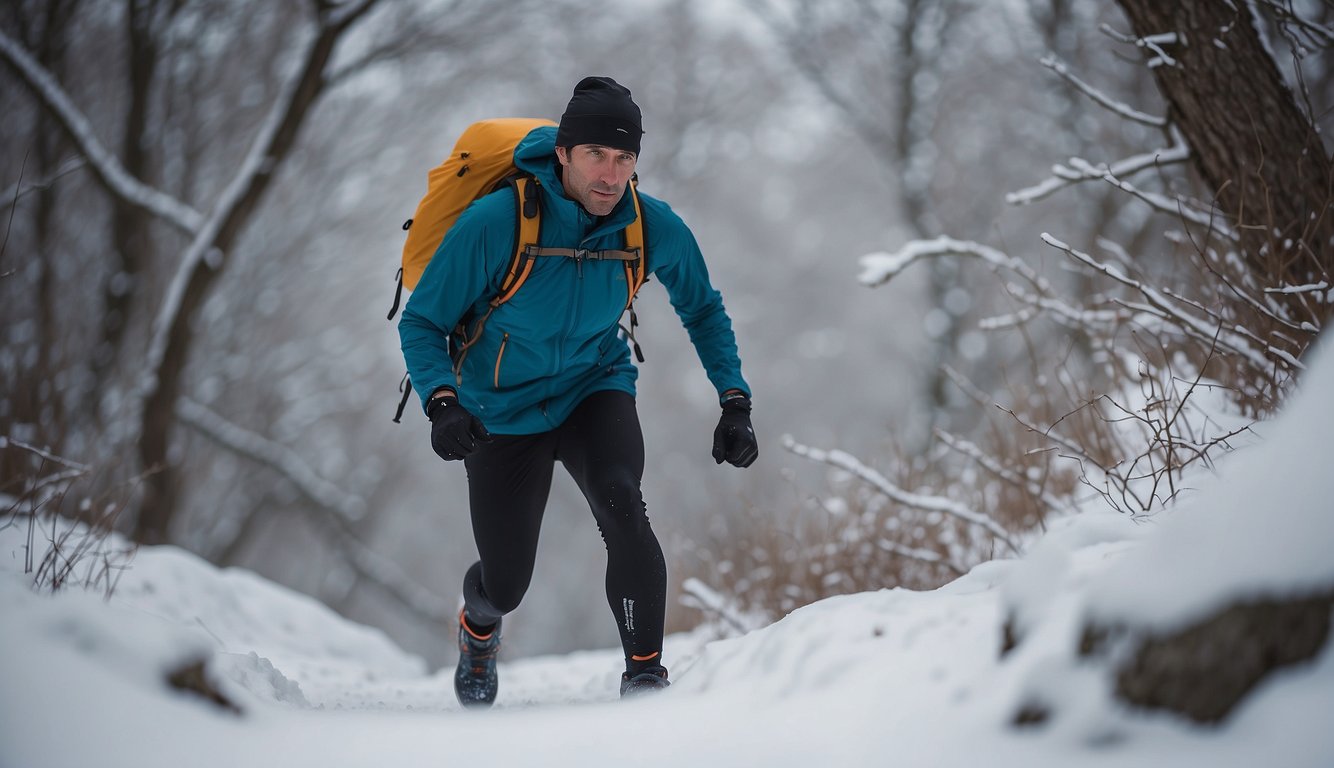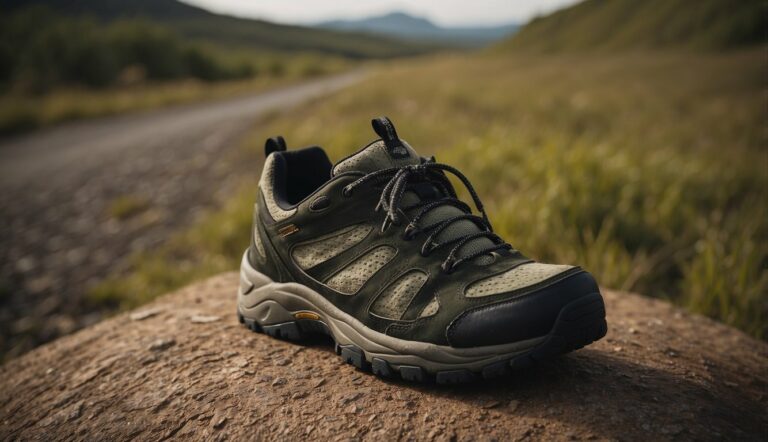Trail Running in Snow and Ice: Essential Gear and Safety Strategies for Winter Terrain
Trail running in the winter presents unique challenges and rewards. Facing snowy and icy conditions requires preparation and caution. Having the right gear is crucial to ensure safety and improve traction on slippery trails. Traction devices for shoes, like microspikes, can provide the necessary grip to prevent falls.
Safety is paramount when running through snow and ice. I recommend carrying emergency gear, including a waterproof jacket and a hat to retain body heat. Also, adjusting your running technique can reduce the risk of injury. A flatter footfall increases surface contact with the ground, aiding in stability.
Running with a friend enhances safety, and timing your runs can offer more daylight and better visibility. Selecting the proper layers to manage body temperature helps maintain comfort. It’s imperative to have a warm, moisture-wicking base layer topped with an insulated jacket to handle the winter temperatures.
Essential Gear for Trail Running in Winter
When trail running in winter, the proper gear is crucial for safety and performance. From specialized footwear providing traction on snow and ice to layered clothing that maintains body heat without causing overheating, I’ll guide you through choosing the essentials.
Footwear Selection
Shoes: For winter trail running, I choose shoes with a combination of water-resistance, insulation, and traction. Gore-Tex® is my go-to material for its waterproof and breathable properties.
- Trail Running Shoes: Hoka One One Speedgoat 4 is a reliable choice.
- Traction Devices: Microspikes or Yaktrax can be essential for additional grip.
Socks: Always pair your footwear with socks that wick moisture and provide insulation, such as merino wool socks.

Layering Strategy
Base Layer: A warm, moisture-wicking, long-sleeve merino top is my first layer to ensure comfort during the run.
Additional Layers:
- Insulated Vest: Adds warmth without restricting arm movement.
- Running Jacket: The Arc’teryx Norvan Shell Jacket is lightweight and waterproof.
- Running Tights/Pants: Opt for insulated variants to protect your legs.
Accessorizing for Warmth and Visibility
Headwear:
- Beanie: The On Lumos Beanie offers warmth.
- Neck Gaiter: Doubles as a face cover and additional neck insulation.
Handwear:
- Gloves: For moderate conditions.
- Mittens: When the temperature drops significantly.
Visibility:
- Headlamp: A critical safety item for visibility in short winter days.
- Reflective Vest: Ensuring I’m visible to others is a priority.
Selecting the right gear enhances the trail running experience, making it safer and more enjoyable. The key is to find the perfect balance between warmth, breathability, and mobility.
Safety Tips for Snowy and Icy Conditions
When trail running in snowy and icy conditions, prioritizing safety is essential. My experience has taught me that the right gear and awareness can make all the difference in maintaining stability, warmth, and visibility.
Traction and Stability
Traction is critical on icy trails. I recommend attaching microspikes or Yaktrax to your waterproof trail running shoes for a secure grip. These devices act like tire chains for your feet, significantly improving stability and reducing the risk of slips and falls.
- Microspikes: Ideal for rugged, uneven terrains with thick ice.
- Yaktrax: Suitable for packed snow and moderate ice conditions.
Table: Traction Devices Comparison
| Feature | Microspikes | Yaktrax |
|---|---|---|
| Grip Strength | Excellent on ice | Good on packed snow |
| Durability | High | Moderate |
| Suitability | Rough terrain | Moderate terrain |
Preventing Hypothermia and Frostbite
In cold weather running, preventing hypothermia and frostbite is crucial. I wear layers that can be adjusted easily, ensuring they’re moisture-wicking to keep sweat away from my skin. Always cover extremities with gloves and a hat, as they’re most susceptible to frostbite.
- Layers: Moisture-wicking base, insulating mid-layer, windproof and waterproof outer layer.
- Extremities: Insulated, waterproof gloves and hats are non-negotiable.
Navigating in Low Visibility
Running in the dark increases risks. A headlamp is a must-have to illuminate the trail and keep hands free. It’s wise to run at a conservative pace to react to unexpected obstacles, and always let someone know your route before heading out.
- Headlamp: Choose one with adjustable brightness and a wide beam.
- Visibility Gear: Reflective vests and markers on gear help you remain visible to others.
While these tips cover traction, temperature control, and visibility, each run is unique, and adapting to changing conditions is part of the winter trail running experience. Stay safe out there!
Nutrition and Hydration in Cold Weather

In cold weather conditions, staying hydrated and properly fueled is crucial for maintaining energy levels and preventing hypothermia. Cold can suppress thirst and hunger cues, making it essential to consciously manage your nutrition and hydration.
Hydrating Effectively
To ensure adequate hydration during cold-weather runs, I recommend using a hydration pack or running vest equipped with an insulated tube to prevent freezing. Choosing warm beverages can help maintain your core temperature and make drinking more appealing in cold conditions. Additionally, it’s vital to drink at regular intervals, as you may not feel thirsty, yet your body continues to lose fluid through respiratory water loss and sweat.
- Hydration Tips:
- Pre-run: Consume about 17-20 fl oz of water 2-3 hours before running.
- During the run: Aim for 5-10 fl oz every 20 minutes, depending on your sweat rate and the intensity of your run.
- Post-run: Rehydrate with 16-24 fl oz of fluid for every pound of body weight lost.
Fueling Strategies for Cold Climates
Running in the cold increases caloric expenditure, necessitating more frequent fueling to maintain energy levels. Consuming easily digestible carbohydrates regularly throughout your run can keep blood sugar stable and energy high. I recommend carrying snacks like energy gels, bars, or dried fruits in your running vest for easy access.
- Caloric Intake:
- Pre-run: Have a small, high-carbohydrate meal or snack 1-2 hours before embarking.
- During the run: Every 45 minutes, ingest 30-60 grams of carbohydrates.
- Post-run: Within 30 minutes, refuel with a mix of carbohydrates and protein to aid recovery.
By integrating these specific hydration and nutrition strategies into your cold-weather running routine, you’ll maintain proper energy levels and hydration, which are both critical to your performance and safety in winter conditions.
Training and Techniques for Winter Terrain
When tackling winter trails, optimizing your stride and building endurance are key for a safe and effective workout. Proper technique and conditioning will help you manage snowy and icy conditions confidently.
Adapting Your Stride
On winter trails, a shorter, more stable stride helps maintain balance on unpredictable surfaces. Focus on keeping your feet under your center of gravity to avoid slipping. Here’s how to adjust your stride:
- Shorten your stride: Reduce stride length to increase stability.
- Stay upright: Keep your body centered with a slight forward lean.
- Foot placement: Aim for flat-footed landings to distribute weight evenly.
Building Endurance on Winter Trails
Winter trail running can be more taxing on the body due to the increased effort needed to navigate through snow and mud. Here’s a plan to enhance your winter trail endurance:
- Start Slow: Begin with shorter runs to acclimate your body to the cold and terrain.
- Progress Gradually: Increase your distance by no more than 10% per week.
- Cross-Train: Incorporate exercises like snowshoeing to build strength and adapt to the conditions in areas like Alaska.
Remember, proper gear such as a moisture-wicking running jacket, thermal running socks, and trail-specific footwear is essential for maintaining health and comfort during your winter runs.
Preparing for Changeable Winter Weather

Winter trails can be unpredictable, demanding adaptability in your gear choices and a solid plan for emergencies. The right preparation increases both safety and enjoyment on the trail.
Adapting to Varied Winter Climates
Winter conditions vary greatly, ranging from wet and above freezing, to dry and bitterly cold. Clothing in layers offers the flexibility needed to adapt to these changes.
My first layer is always moisture-wicking, followed by an insulating fleece to retain heat. I then add a waterproof yet breathable outer shell to protect against wind and precipitation. As for footwear, I opt for trail shoes with good grip, designed for snow and ice to maintain mobility.
- Base Layer. Moisture-wicking, snug-fitting materials like merino wool.
- Mid Layer. Fleece or synthetic insulation for warmth.
- Outer Layer. Waterproof and windproof jacket for protection.
A hat or headband is necessary to reduce heat loss, with the choice depending on the intensity of the conditions. In milder weather, a headband may suffice to protect the ears, while colder temperatures necessitate a full hat.
Emergency Readiness for Trail Runners
I’ve learned that on winter trails, preparation for emergencies is as critical as the run itself. I always pack an emergency shelter, whistle, and first aid kit. The whistle can be crucial for alerting others if you’re in distress and out of sight. A headlamp is a must-have for visibility as winter days are shorter, and conditions can obscure natural light.
- Emergency Kit
- Shelter: Compact, lightweight, and easy to deploy.
- Whistle: Loud and accessible at all times.
- First Aid: Basic supplies to handle minor injuries.
- Headlamp: Ensure it’s fully charged or carry spare batteries.
Each item I choose is based on its usefulness without adding unnecessary weight or hindering movement. Trail runners need to be agile, and a heavy pack could impede this mobility.






